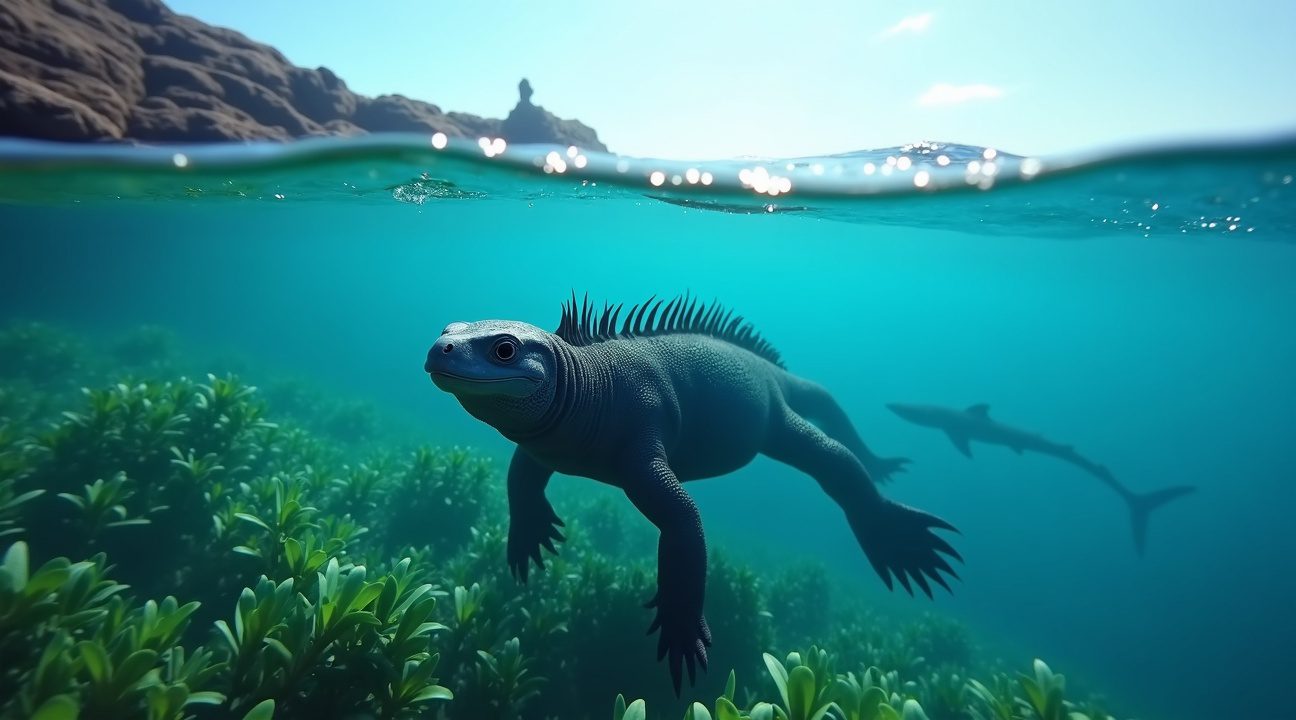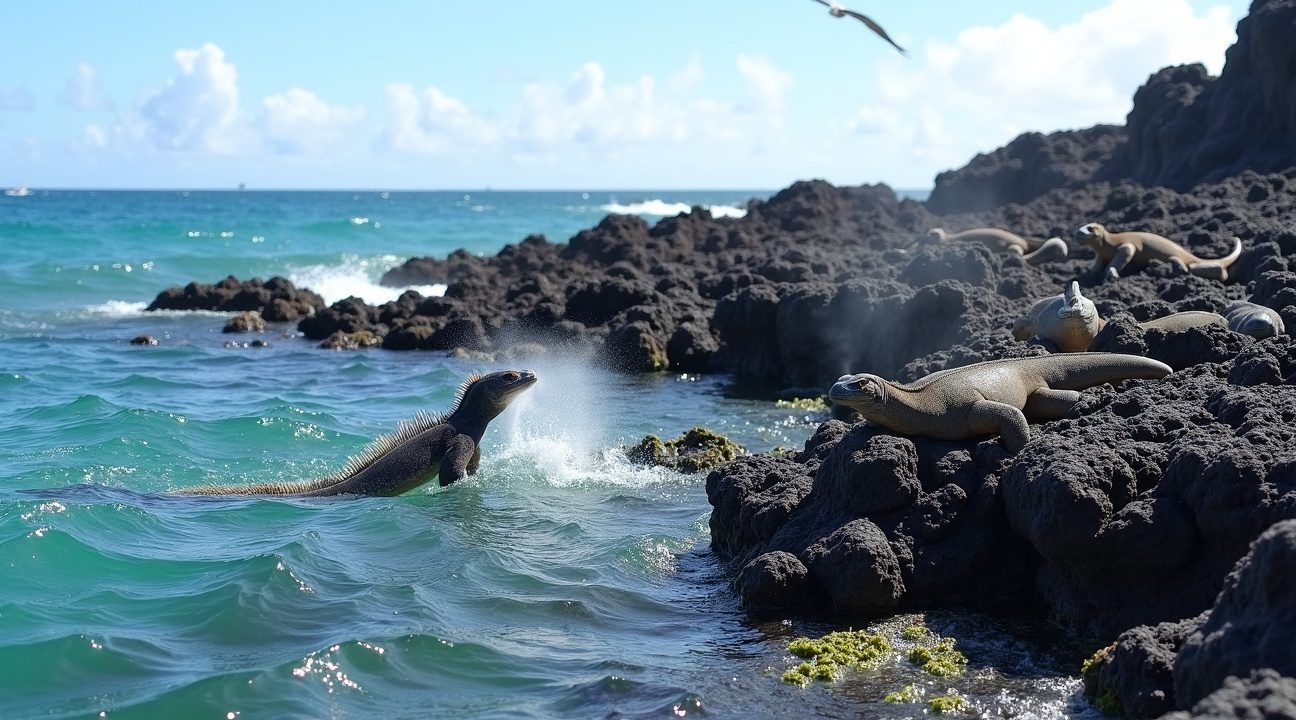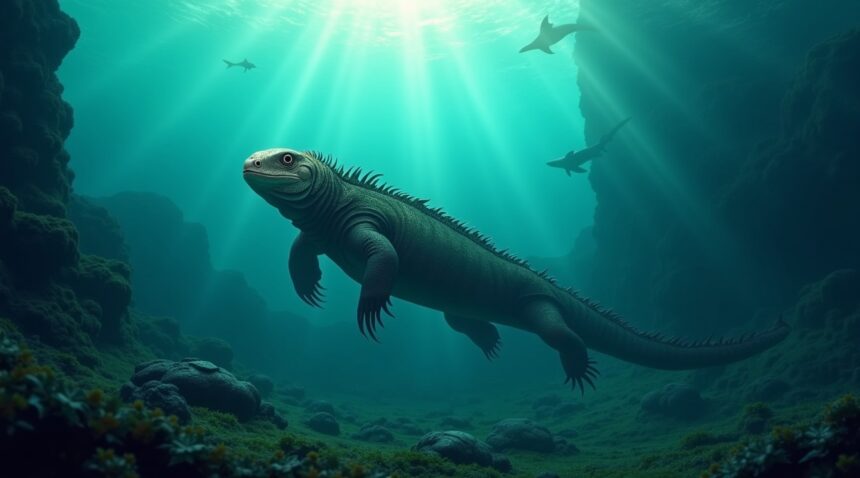Marine iguanas possess an extraordinary ability to dramatically slow their heart rate by up to 50% during underwater dives, creating an almost undetectable cardiac signature that helps them avoid predators like sharks.
While folklore has exaggerated the idea that marine iguanas can stop their hearts for 45 minutes, the truth is still impressive. This specialized physiological response, known as bradycardia, allows them to conserve oxygen and evade detection from predators such as sharks, which are capable of sensing heartbeats from up to 13 feet away. Although they can’t stop their hearts completely, this skill grants them a vital evolutionary edge in their rugged, aquatic habitat.
Key Takeaways
- Heart Rate Reduction: Marine iguanas can reduce their heart rate by up to 50% through bradycardia during underwater dives, but cannot fully stop their hearts for extended periods.
- Dive Duration: Most routine foraging dives last from 3 to 10 minutes, with typical dives ranging from 15 to 30 minutes. Rare dives can extend up to an hour.
- Dive Depth and Behavior: Only about 5% of marine iguanas dive offshore to collect deeper-growing algae. Larger males can dive as deep as 30 meters, while smaller individuals remain in shallow tidal zones.
- Thermoregulation: As ectothermic reptiles, marine iguanas must bask in the sun after diving to warm their bodies and maintain proper metabolic function.
- Habitat and Conservation Status: These are the world’s only marine lizards, endemic exclusively to the Galápagos Islands. Population estimates suggest fewer than 210,000 remain, and they are currently classified as Vulnerable by the IUCN.
The Heart Rate Deception: How Marine Iguanas Fool Sharks Underwater
Marine iguanas possess a remarkable ability that sounds like science fiction, yet the truth is far more fascinating than the myth. While they can’t literally stop their hearts for 45 minutes, these extraordinary reptiles can dramatically slow their heart rate by up to 50% during underwater dives. This incredible physiological response, called bradycardia, serves a dual purpose: conserving precious oxygen and avoiding detection by predators.
Understanding the Physiological Mechanism
The science behind this adaptation reveals how marine iguanas have evolved to thrive in their harsh ocean environment. During dives, their heart activity decreases to levels that make detection extremely difficult for predators sensitive to cardiac sounds. Sharks can sense heartbeats from up to four meters (13 feet) away, making this adaptation crucial for survival. The dramatic reduction in heart activity creates an almost undetectable cardiac signature, effectively rendering these iguanas invisible to their most dangerous predators.
This near cessation of heart activity represents one of nature’s most clever survival strategies. Rather than complete cardiac arrest, which would be biologically impossible, marine iguanas achieve a state where their hearts beat so slowly that predatory detection becomes nearly impossible. The oxygen conservation aspect proves equally important, as slower heart rates reduce metabolic demands during extended underwater foraging sessions.
Marine iguanas aren’t alone in utilizing this adaptation. Sea turtles and marine mammals also employ bradycardia during deep dives, though few achieve the dramatic heart rate reductions seen in these unique marine reptiles. The comparison highlights how widespread this diving adaptation has become among ocean-dwelling vertebrates.
The claims suggesting complete cardiac arrest for 45 minutes stem from misunderstandings of this complex physiological process. Scientists studying these creatures have documented significant reductions in heart activity, but complete cessation would result in death rather than successful predator avoidance. The reality proves far more impressive than the exaggerated claims, showcasing how evolution has fine-tuned these animals for their challenging marine lifestyle.
This remarkable adaptation allows marine iguanas to feed on algae in shark-infested waters while maintaining their status as one of the ocean’s most successful diving reptiles. Their ability to fool predators through cardiac deception demonstrates nature’s ingenuity in developing survival strategies that seem almost too incredible to believe.
Underwater Endurance: The Reality Behind Marine Iguana Dive Times
Marine iguanas possess remarkable diving abilities that allow them to access underwater algae beds along the rocky coastlines of the Galápagos Islands. Most dives last between 15 and 30 minutes, though these impressive reptiles can remain submerged for varying periods depending on their size and diving objectives.
Typical Dive Duration and Depth Patterns
Average marine iguana dive times fall within the 3 to 10-minute range for routine foraging activities. Exceptional cases have documented dives lasting up to one hour, though such extended underwater periods are extremely rare. Most underwater excursions stay well under the 10-minute mark as these reptiles efficiently gather their algae meals and return to the surface.
Dive depths present equally fascinating patterns, with maximum recorded depths reaching 30 meters or approximately 98 feet. Other research indicates more conservative diving ranges around 12 meters (39 feet) to 65 feet, depending on food availability and individual capabilities. The variation in these measurements reflects differences in study locations, individual animal behavior, and environmental conditions across different Galápagos sites.
Size-Based Diving Strategies
Larger male marine iguanas consistently perform the deepest and longest dives compared to their smaller counterparts. These impressive males can access deeper algae beds that remain unavailable to smaller individuals, giving them a significant foraging advantage. Size directly correlates with diving capability, as larger bodies can store more oxygen and withstand greater water pressure.
Key points about size-based diving advantages include:
- Larger individuals dive longer and deeper.
- They access offshore feeding grounds with less competition.
- They tolerate colder water better due to thermal inertia.
Interestingly, only about 5% of marine iguanas dive offshore to forage for algae, while the majority stick to shallow intertidal zones for their feeding activities. This selective diving behavior demonstrates how these reptiles optimize their energy expenditure based on their physical capabilities and environmental demands.
Water temperature plays a crucial role in determining dive frequency and duration. Colder waters can extend dive times by slowing metabolic processes, while warmer conditions may require shorter, more frequent diving sessions. Body size influences these temperature effects, with larger individuals better equipped to handle thermal challenges during extended underwater periods.
Compared to other reptilian divers, marine iguana dives appear relatively brief. While their one-hour maximum dive times seem impressive, these achievements pale in comparison to some marine mammals that can remain submerged for hours. However, for a terrestrial reptile that has adapted to marine life, these diving capabilities represent remarkable evolutionary adaptations.
The contrast between large and small males extends beyond simple dive duration differences. Larger males can access algae beds in deeper waters where competition is reduced and food quality may be higher. This size-based advantage creates a clear hierarchy in underwater feeding territories, with the biggest individuals claiming the most productive deep-water foraging grounds.
Seasonal dive trends include:
- Longer and more frequent dives during algae-rich periods.
- Smaller iguanas diving deeper than usual to meet nutritional needs.
Marine iguana dive patterns also vary seasonally, with longer and more frequent dives occurring during periods when algae growth is most abundant. During these peak foraging times, even smaller individuals may attempt longer dives to maximize their nutritional intake before algae availability decreases.
The exceptional nature of dives exceeding 30 minutes cannot be overstated. These extended underwater periods represent the absolute limits of marine iguana physiological capabilities and occur only under specific circumstances. Most routine foraging activities conclude well before reaching these extreme durations, as efficiency rather than endurance typically drives their underwater feeding strategies.
Recent observations of marine creatures have highlighted how different species adapt to underwater environments, and marine iguanas stand out for their unique combination of terrestrial and aquatic adaptations. Their ability to transition from basking on volcanic rocks to diving for algae represents one of nature’s most successful evolutionary experiments in reptilian marine adaptation.

Cold-Blooded Survival: The Challenge of Diving in Frigid Waters
Marine iguanas face unique challenges that set them apart from other diving animals. As ectothermic creatures, they can’t generate their own body heat and must rely entirely on external sources to maintain optimal body temperature. This fundamental difference creates a complex survival equation that requires precise timing and energy management.
Temperature-Dependent Metabolism and Energy Balance
Body temperature directly controls every aspect of a marine iguana’s physiology. When these reptiles plunge into the cold Galapagos waters, their metabolic rate drops significantly, which actually works in their favor during extended dives. Lower temperatures reduce oxygen consumption, allowing them to remain submerged longer while their hearts slow to an almost imperceptible rhythm through bradycardia.
However, this temperature dependency creates a constant balancing act. After each diving session, marine iguanas must return to shore and bask extensively on sun-warmed rocks to restore their body heat. This basking period isn’t optional—it’s critical for maintaining the energy levels needed for digestion, movement, and future foraging expeditions. Unlike marine mammals that generate internal heat, these reptiles are completely dependent on environmental conditions for thermal regulation.
Strategic Adaptations for Survival
Marine iguanas have developed several key strategies to maximize their underwater foraging success while minimizing risks:
- Precise dive timing based on tidal conditions and solar availability for post-dive warming
- Enhanced oxygen conservation through controlled bradycardia and reduced metabolic activity
- Rapid surfacing abilities when detecting potential threats like sharks
- Efficient algae-gathering techniques that maximize nutrition per dive duration
- Strategic positioning near warming zones for quick temperature recovery
The predation risk adds another layer of complexity to their survival strategy. While diving, marine iguanas must remain alert for sharks and other predators, ready to abort their feeding sessions at any sign of danger. This constant vigilance, combined with their need for extensive basking periods, limits their daily foraging windows compared to warm-blooded marine animals.
Their remarkable ability to slow their hearts for up to 45 minutes underwater represents one of nature’s most impressive adaptations to cold-water diving. This physiological response, combined with their temperature-dependent metabolism, allows them to extract maximum nutrition from limited dive opportunities while surviving in one of the ocean’s most challenging environments. Much like how marine giants have adapted to specific oceanic conditions, marine iguanas showcase evolution’s capacity for specialized survival mechanisms.

The World’s Only Marine Lizard: An Evolutionary Marvel
I’ve always been fascinated by creatures that defy conventional expectations, and marine iguanas stand as perhaps the most extraordinary example of reptilian adaptation. These remarkable lizards hold the distinction of being the only marine lizard species on Earth, a title that reflects millions of years of evolutionary refinement in one of the planet’s most isolated ecosystems.
The Galapagos Islands serve as the exclusive home for these incredible creatures, where 11 distinct subspecies have evolved across the archipelago’s various islands. Each subspecies has adapted to specific local conditions, creating a living laboratory of evolution that continues to astound researchers and visitors alike. This endemism makes marine iguanas irreplaceable components of their ecosystem, much like how marine giants occupy unique ecological niches in ocean environments.
Population and Conservation Challenges
Current estimates place the global marine iguana population at fewer than 210,000 individuals, a number that might seem substantial but becomes concerning when considering the species’ limited range and vulnerability to environmental changes. The IUCN Red List classifies marine iguanas as Vulnerable, reflecting several serious threats that could impact their long-term survival.
Conservation experts identify several critical challenges facing these unique lizards:
- El Niño events pose the most severe threat, potentially causing up to 90% mortality on some islands during extreme weather cycles
- Invasive species introduce new predation pressures and competition for resources
- Habitat degradation from human activities affects nesting sites and feeding areas
- Climate change disrupts ocean temperatures and food availability
- Disease outbreaks can rapidly spread through dense populations
El Niño events particularly devastate marine iguana populations because these weather patterns drastically reduce the algae that forms their primary food source. During severe El Niño years, I’ve observed that the normally robust iguanas become emaciated as their marine food disappears, forcing them into a desperate struggle for survival. The species’ remarkable ability to stop their hearts during extended dives becomes both a survival mechanism and a testament to their extraordinary adaptation to marine life.
Invasive species present another significant challenge, as introduced cats, dogs, and rats prey on eggs and juveniles while competing for territory. These non-native predators didn’t evolve alongside marine iguanas, creating an unnatural pressure that the lizards’ defensive strategies haven’t had time to address through natural selection.
Research efforts continue to monitor population dynamics across the different subspecies, with some islands showing more stable numbers than others. Scientists have discovered that population recovery after major mortality events can take several years, making consecutive environmental stressors particularly dangerous for long-term species survival.
The unique nature of marine iguanas as the only marine lizard species makes their conservation particularly critical from a biodiversity perspective. Their evolutionary adaptations, including their extraordinary cardiovascular control during diving, represent millions of years of specialized development that cannot be replicated elsewhere. Conservation programs focus on protecting nesting beaches, monitoring population health, and controlling invasive species to ensure these remarkable creatures continue to thrive in their Galapagos home.
Understanding marine iguana conservation also provides insights into broader ecosystem health, as these lizards serve as indicators of ocean condition changes. Their dependence on marine algae makes them sensitive barometers for ocean temperature fluctuations and nutrient availability, similar to how underwater environments preserve evidence of environmental changes over time.
Algae Dining and Salt Sneezing: Unique Feeding Behaviors
Marine iguanas have evolved fascinating feeding strategies that allow them to thrive in their harsh oceanic environment. These remarkable reptiles sustain themselves almost exclusively on marine algae that flourish on volcanic coastal rocks throughout the Galapagos Islands.
Specialized Feeding Patterns and Diving Behaviors
The feeding ecology of marine iguanas varies dramatically based on size and sex. Larger males venture into deeper offshore waters to access more nutritious algae, while females and smaller males remain in shallow tidal pools during low tide. Surprisingly, only about 5% of the entire population participates in offshore diving, making this behavior a specialized skill reserved for the most capable individuals.
During mating season, large males demonstrate incredible endurance by fasting for up to two weeks. This extended period without food causes them to lose as much as 25% of their body weight, yet they continue defending territories and competing for mates. After the breeding season concludes, these weakened males must quickly return to feeding to restore their depleted energy reserves.
Salt Management and Social Dynamics
Marine iguanas possess a remarkable physiological adaptation that allows them to consume saltwater plants without fatal consequences. They filter excess salt from their blood and expel concentrated salt crystals through specialized glands in their nostrils. Observers frequently witness these iguanas “sneezing” white crystalline deposits, which often accumulate on their heads like tiny salt crowns.
Despite their impressive ability to gather in massive groups for sun basking and warmth, marine iguanas aren’t truly social creatures. Their clustering behavior stems from necessity rather than companionship – they simply tolerate each other’s presence while seeking optimal basking spots on warm volcanic rocks. These gatherings help maintain body temperature after cold feeding sessions in the frigid ocean waters.
The feeding strategy of marine iguanas showcases nature’s incredible adaptability. While marine creatures often face challenges accessing food sources, these unique reptiles have mastered both underwater foraging and salt regulation. Their ability to stop their hearts during extended dives becomes even more impressive when considering the energy demands of their specialized diet and the need to process salt-laden vegetation in such an extreme environment.

Social Tolerance: Survival Through Shared Warmth
Marine iguanas demonstrate a fascinating survival strategy that blurs the line between individual necessity and collective benefit. These remarkable reptiles gather in dense clusters on rocky shorelines, creating what appears to be a social gathering but serves a purely practical purpose. After their lengthy dives in frigid ocean waters, where they can stop their hearts for extended periods, these cold-blooded creatures face a critical challenge: rapidly warming their bodies to restore normal function.
The clustering behavior represents social tolerance rather than genuine sociability. Individual iguanas will press closely against neighbors, sometimes piling several layers deep, without engaging in typical social behaviors like grooming or play. This tolerance stems from the immediate survival benefits that shared warmth provides. Each iguana contributes body heat to the group while simultaneously receiving warmth from others, creating an efficient thermal exchange system.
Energy Conservation Through Strategic Positioning
Basking becomes significantly more effective when multiple individuals participate. I observe that iguanas position themselves strategically within these clusters, with smaller individuals often finding spots between larger ones to maximize heat absorption. The arrangement isn’t random – each iguana seeks the position that offers the greatest thermal advantage while maintaining access to quick escape routes if predators approach.
This clustering behavior directly supports their remarkable diving abilities. After spending up to 45 minutes underwater with slowed or stopped hearts, marine iguanas emerge with drastically reduced body temperatures. The shared warmth from group basking allows them to restore their metabolic functions much faster than solitary basking would permit. This efficiency proves crucial in environments where food sources require repeated diving sessions.
The tolerance displayed during these basking sessions extends only as far as thermal necessity demands. Once body temperatures reach optimal levels, iguanas typically disperse and resume their normally territorial behaviors. This temporary cooperation highlights how environmental pressures can override typical behavioral patterns when survival depends on it. The clustering represents one of nature’s most practical examples of cooperation without communication, where individual survival strategies align perfectly with collective benefits purely through shared physical proximity and mutual heat exchange.
https://www.youtube.com/watch?v=K0EBv_1k8xklgM
Sources:
Wikipedia: “Marine iguana”
Galapatours: “Galapagos Marine Iguana”
Journal of Experimental Biology: “The relationship between heart rate and rate of oxygen consumption in the Galapagos marine iguana”
Scuba Diving: “13 Facts You Didn’t Know About the Marine Iguana”
Animalia.bio: “Marine Iguana – Facts, Diet, Habitat & Pictures on Animalia.bio”

